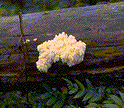Archived Content
Information identified as archived on the Web is for reference, research or recordkeeping purposes. It has not been altered or updated after the date of archiving. Web pages that are archived on the Web are not subject to the Government of Canada Web Standards. As per the Communications Policy of the Government of Canada, you can request alternate formats on the Contact Us page.
Yellow Pitted Rot
Hericium abietis (Weir ex Hubert) K. A. Harrison
(= Hydnum abietis Weir ex Hubert)
Basidiomycotina, Aphyllophorales, Hydnaceae
Hosts: In B.C., Hericium abietis causes a butt and trunk rot of amabilis, grand, and subalpine fir, mountain and western hemlock, and occasionally Sitka spruce. Elsewhere in North America it has also been found on Douglas-fir and Engelmann spruce.
Distribution:Hericium abietis is restricted to western North America, and is not found east of the Rocky Mountains.
Identification: The fruiting bodies are annual, soft, fleshy, and white, and have many downward-directed spines, 1-2 cm long when fully developed. Spines are produced on a much-branched fleshy stalk (coral-like) (Figs. 14a, 14b).
The early stage of the decay appears as a yellow to brown heartwood stain. Later, elongated pits, about 1 cm long, form, which are oriented longitudinally in the wood (Fig. 14c). These pits are usually empty but may contain yellow to white mycelium. The rot is similar to that of red ring rot (Phellinus pini) but with yellow-pitted rot, the pits are usually longer and have blunt ends and the general outline of the decay in cross-section tends to be irregular to honeycomb.
Microscopic Characteristics: Growth in culture relatively slow, mat initially white-tan, then white-yellow-brown, laccase variable and weak, chlamydospores, clamp connections. Basidiospores white, round or nearly so, smooth or minutely roughened, amyloid, 4.5-5.5 x 4-5 µm. Nobles (1965): 2 3 15 34 36 (38) (39) 47 (48) 51 (53) 55 60.
Damage: The presence of a fruiting body indicates extensive decay in the stem. Hericium abietis has been reported to reduce merchantable volume by up to 3.1% in amabilis fir.
Remarks: The fruiting bodies are generally found on slash and on the ends of cut logs but they may also form on wounds on living trees. Because of their fleshy nature, they are short lived.
References:
Buckland, D. C., R. E. Foster, and V. J. Nordin. 1949. Studies in forest pathology VII. Decay in western hemlock and fir in the Franklin River area, British Columbia. Can. J. For. Res. 27:312-331.
Filip, G. M., A. M. Kanaskie, and S. J. Frankel. 1984. Substantial decay in Pacific silver fir caused by Hericium abietis. Plant Disease 68:992-993.
Ginns, J. H. 1985. Hericium in North America: cultural characteristics and mating behavior. Can. J. Bot. 63:1551-1563.
Figures
Click on any image to see the full size version.
Press "Back" on your browser to return to this screen.

Figure 14a: Coral-like fruiting bodies of Hericium abietis.
 Figure 14b: Coral-like fruiting bodies of Hericium abietis.
Figure 14b: Coral-like fruiting bodies of Hericium abietis.
 Figure 14c: Advanced decay:white pocket rot in fir.
Figure 14c: Advanced decay:white pocket rot in fir.
 This Web page has been archived on the Web.
This Web page has been archived on the Web.